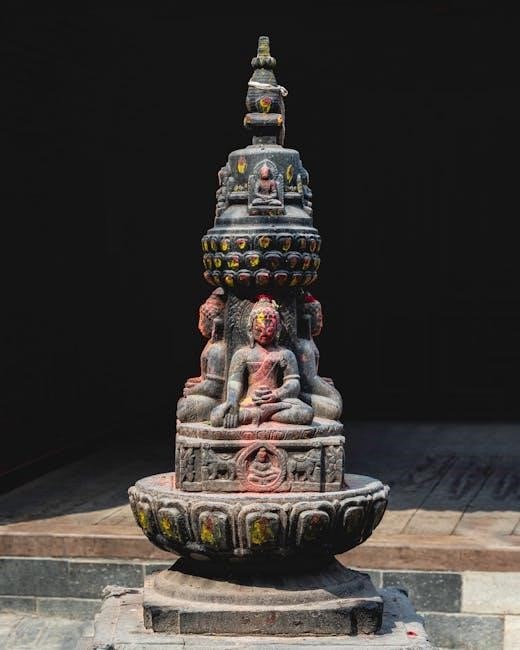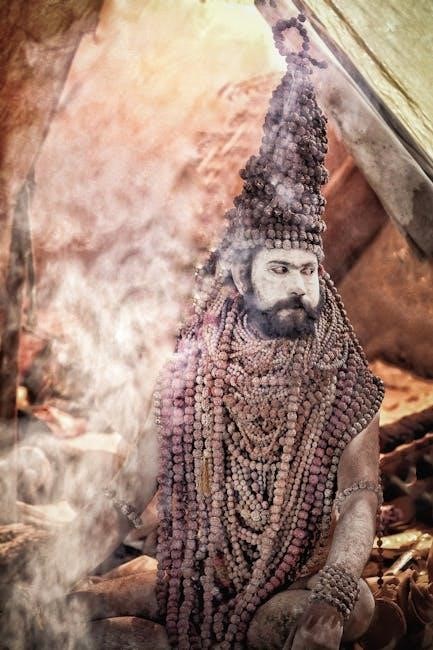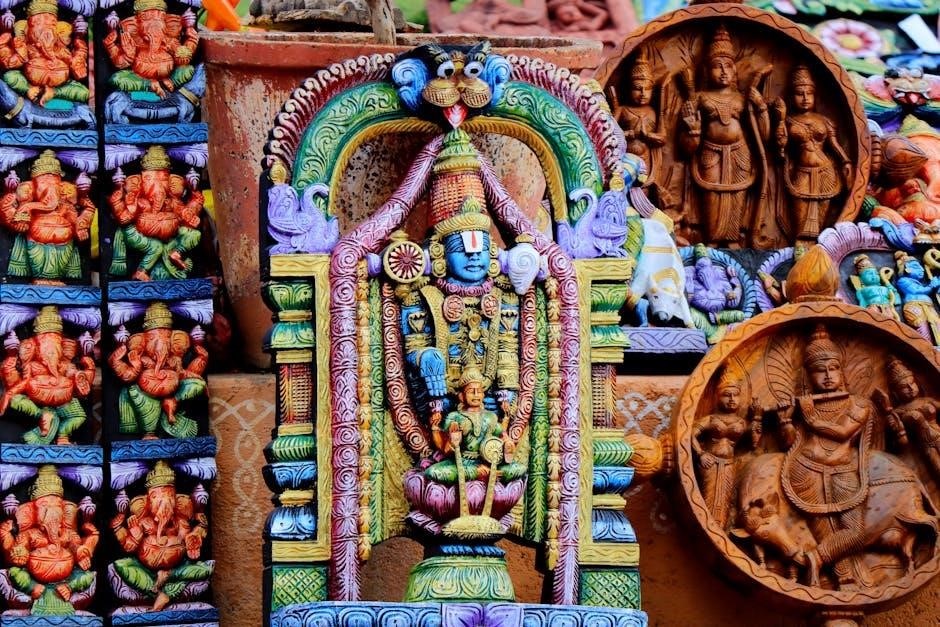Vishnu Sahasranama: An Overview
The Vishnu Sahasranama is a sacred hymn containing a list of 1,000 names of Vishnu. It is a revered scripture in Hinduism, particularly within Vaishnavism. The hymn originates from the epic Mahabharata and is recited for spiritual merit.
Definition and Meaning
The term “Vishnu Sahasranama” is a Sanskrit phrase that translates to “the thousand names of Vishnu.” “Sahasra” means “thousand,” and “nama” signifies “name.” Thus, the Vishnu Sahasranama is a compilation of one thousand names, epithets, and attributes of Lord Vishnu, who is considered a principal deity in Hinduism and the Supreme God in Vaishnavism. Each name represents a specific quality, aspect, or manifestation of Vishnu. Reciting these names is considered a powerful form of prayer and meditation, believed to bestow blessings, remove obstacles, and lead to spiritual liberation.
Significance in Vaishnavism
In Vaishnavism, the Vishnu Sahasranama holds immense significance as a central and revered text. Vaishnavites consider Vishnu to be the Supreme God, and the Sahasranama serves as a primary means of connecting with and glorifying Him. Reciting the thousand names is believed to be a potent form of devotion, capable of granting devotees a deeper understanding of Vishnu’s divine nature and attributes. The Sahasranama is often chanted during pujas, festivals, and other religious ceremonies, solidifying its integral role in Vaishnava spiritual practices. It is through this recitation that devotees seek blessings, protection, and ultimately, liberation.

Origin and History
The Vishnu Sahasranama’s origin is deeply rooted in Hindu tradition. It is an integral part of the epic Mahabharata; The hymn emerged from a conversation during the Kurukshetra war, marking its historical importance.
The Mahabharata Connection
The Vishnu Sahasranama is prominently featured within the Anushasana Parva of the Mahabharata. This epic narrative serves as the foundational source of the hymn, establishing its sacred context. Its inclusion underscores its significance in Hindu scriptures, linking it to core philosophical and spiritual teachings. The dialogue and circumstances surrounding its revelation within the Mahabharata provide deeper meaning, enriching its importance for devotees. This connection to the Mahabharata is crucial for understanding its enduring reverence and widespread acceptance. It firmly establishes the Sahasranama’s place within Hindu tradition and practice.
Bhishma’s Upadesha to Yudhishthira
Bhishma, the venerable grandsire in the Mahabharata, imparts the Vishnu Sahasranama to Yudhishthira on his deathbed. This sacred teaching, known as Upadesha, occurs in the presence of Lord Krishna. Yudhishthira seeks enlightenment about the Supreme Being, prompting Bhishma to reveal the thousand names of Vishnu. This moment is highly revered, as Bhishma, a paragon of righteousness, shares profound wisdom. The context of this Upadesha amplifies the Sahasranama’s spiritual weight. Bhishma’s discourse to Yudhishthira highlights the importance of devotion and understanding of Vishnu’s attributes. The scene underscores the hymn’s transformative power, offering solace and guidance.
Maharshi Vyasa, the revered sage, is traditionally credited as the author of the Vishnu Sahasranama. Vyasa, also known as Veda Vyasa, is a central figure in Hindu tradition, attributed with composing the Mahabharata, Puranas, and other significant scriptures. As the compiler of the Vedas, Vyasa’s authority is paramount in Hindu literature. His authorship lends immense credibility and sanctity to the Sahasranama. Vyasa’s profound knowledge and spiritual insight are reflected in the hymn’s structure and content; The inclusion of the Sahasranama within the Mahabharata further emphasizes Vyasa’s role. His divine wisdom makes the hymn a powerful tool.
Structure and Content
The Vishnu Sahasranama comprises one thousand names of Lord Vishnu. Its structured verses explore Vishnu’s attributes and cosmic functions. It also includes prayers and supplementary hymns. The content is profoundly devotional.
The Thousand Names of Vishnu
The core of the Vishnu Sahasranama is the enumeration of one thousand names, each a unique epithet describing a distinct attribute, aspect, or manifestation of Lord Vishnu. These names are not mere labels but are potent mantras carrying profound spiritual significance. Reciting these names is believed to invoke Vishnu’s blessings and bestow various benefits upon the devotee. Each name is a key to unlocking a deeper understanding of Vishnu’s cosmic role and divine nature. The thousand names serve as a comprehensive guide to contemplating the Supreme Being. Through them, devotees can connect with the divine and attain spiritual liberation, ultimately achieving fulfillment.
Key Names and Their Meanings
Within the thousand names of Vishnu, certain names stand out due to their profound meanings and frequent usage in devotional practices. “Vishnu,” meaning “the all-pervading one,” encapsulates His omnipresence. “Narayana,” the one who resides in the waters, represents the cosmic waters of creation. “Madhava,” the consort of Lakshmi, symbolizes prosperity and divine grace. “Govinda,” the protector of cows, signifies His role as the preserver of dharma. “Kesava,” the one with beautiful hair, represents beauty and auspiciousness. Understanding these key names provides a deeper insight into Vishnu’s multifaceted nature. Each name acts as a focal point for meditation, allowing devotees to connect with specific aspects of the divine.
Inclusion of Lakshmi Ashtotram and Panchayuda Stotram
Many editions of the Vishnu Sahasranama also include the Lakshmi Ashtotram and Panchayuda Stotram, enhancing the devotional experience. The Lakshmi Ashtotram, containing 108 names of Goddess Lakshmi, invokes prosperity and well-being. Its inclusion acknowledges the inseparable connection between Vishnu and Lakshmi, representing divine balance. The Panchayuda Stotram praises Vishnu’s five divine weapons: the Sudarshana Chakra, Panchajanya conch, Kaumodaki mace, Nandaka sword, and Sharanga bow. Reciting this stotram offers protection from negativity and signifies the power of divine weapons. The addition of these stotras enriches the recitation, providing a more comprehensive worship of Vishnu and his divine attributes. Together, they amplify the spiritual benefits of reciting the Sahasranama;

Benefits of Recitation
Reciting the Vishnu Sahasranama is believed to fulfill desires and bestow blessings. It is said to bring vigor, remove obstacles, and lead to spiritual upliftment. The practice is considered highly auspicious.
Fulfillment of Purusharthas
The recitation of Vishnu Sahasranama is traditionally believed to aid in the attainment of the four Purusharthas: Dharma (righteousness), Artha (prosperity), Kama (desire), and Moksha (liberation). Devotees believe that consistent and devoted recitation can guide individuals towards a balanced and fulfilling life, aligning their actions with ethical principles and fostering material well-being. This practice helps channel desires constructively and ultimately leads to spiritual liberation. Therefore, the Sahasranama is seen as a path to holistic development, addressing both worldly and spiritual aspirations, granting devotees the fulfillment of genuine desires.
Blessings and Vigor
Reciting the Vishnu Sahasranama is believed to bestow blessings and vigor upon the devotee. The powerful vibrations and positive energy generated during recitation are thought to purify the mind, body, and spirit. This practice promotes inner strength, resilience, and a sense of well-being. Devotees often experience increased vitality, mental clarity, and emotional stability. The blessings derived from reciting the Sahasranama are said to protect against negative influences and promote overall health, prosperity, and spiritual growth. It revitalizes the individual, fostering a vibrant and harmonious existence filled with divine grace and renewed energy.
Removal of Obstacles
The recitation of Vishnu Sahasranama is highly regarded for its ability to remove obstacles and challenges in life. By invoking the divine names of Lord Vishnu, devotees seek his blessings to overcome difficulties, setbacks, and impediments. The sacred vibrations produced during the chanting are believed to dispel negative energies, clear karmic blockages, and pave the way for success and fulfillment. Regular recitation fosters inner strength, courage, and resilience, enabling individuals to face life’s challenges with unwavering faith and determination. This practice provides divine protection, guidance, and support, ensuring a smoother and more harmonious journey towards one’s goals and aspirations, free from hindrances.

Availability in Sanskrit PDF
The Vishnu Sahasranama in Sanskrit PDF format is widely available online for devotees. These downloadable resources provide easy access to the sacred text, facilitating convenient recitation and study of the hymn.
Downloadable Resources
Numerous websites offer the Vishnu Sahasranama in Sanskrit PDF format for free download, enabling devotees worldwide to access this sacred text. These resources often include the original Sanskrit verses, transliterations, and translations, catering to diverse audiences. Some websites also provide audio recordings of the Sahasranama for convenient listening and chanting. Look for reputable sources to ensure the accuracy of the content. These downloadable PDFs serve as invaluable tools for studying, reciting, and understanding the profound meanings embedded within the thousand names of Lord Vishnu. They facilitate personal devotion and spiritual growth.
Sanskrit Fonts for Easy Reading
Reading the Vishnu Sahasranama in its original Sanskrit can be greatly enhanced by utilizing appropriate fonts. Several Sanskrit fonts, such as Devanagari, are designed for clear and legible rendering of the text. These fonts often feature distinct character shapes and proper spacing, reducing eye strain and improving comprehension. When downloading a Sanskrit PDF of the Vishnu Sahasranama, ensure that the document employs a well-designed font for optimal readability. Some PDFs may even allow you to select your preferred font for a customized reading experience. Choosing the right font can significantly aid in the accurate pronunciation and understanding of the sacred verses.

Different Versions and Commentaries
The Vishnu Sahasranama, due to its immense popularity and significance, exists in various versions and is accompanied by numerous commentaries. These variations may include slight differences in the order or wording of the names. Commentaries, written by various scholars and spiritual leaders, offer diverse interpretations of the meanings and significance of each name. Some commentaries focus on the philosophical aspects, while others emphasize the practical benefits of recitation. Exploring different versions and commentaries can provide a deeper understanding of the Vishnu Sahasranama and its multifaceted interpretations. Studying these resources enriches one’s appreciation for the profound wisdom contained within this sacred hymn, allowing individuals to connect with it on a more personal level.
